Female ticks need blood so that the eggs can develop inside the female tick’s body. After mating with a male (this happens on the host), the female tick simply drops off its host to lay its eggs on the ground.
Depending on the species of tick, the parasite can lay up to 3,000 eggs, which the tick deposits on the ground, often under leaves. What do tick eggs look like and what does a tick nest look like?
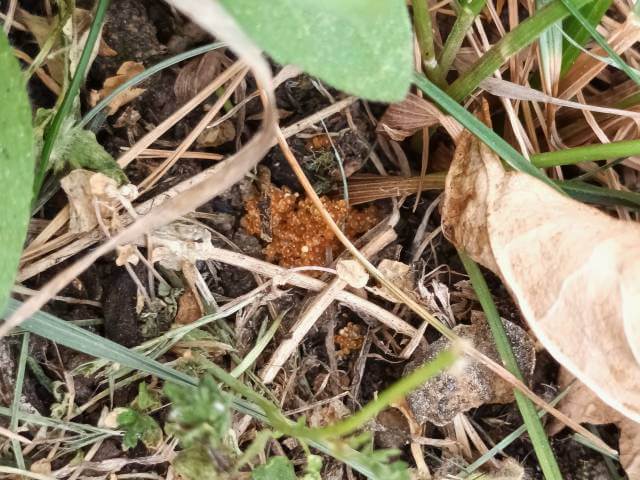
What Does A Tick Nest Look Like?
When adult female ticks feed on a pet unnoticed and the blood meal is complete, they fall off. Then the tick will lay eggs next. And pretty much exactly where it has fallen off from the host. To find a tick nest you need to know what tick eggs look like and what a tick nest looks like.
The eggs of ticks looked like tiny little orange-reddish to brown-colored tiny globules.
But you will not find a proper nest like a bird would build. A tick nest just looks like a loose clutch of eggs. Because ticks simply lay their eggs on the ground where grass grows or under leaves or similar places where there is a bit of shade and the nest is out of direct sunlight.
A tick nest looks like a cluster of reddish-brown tiny beads clumped together.
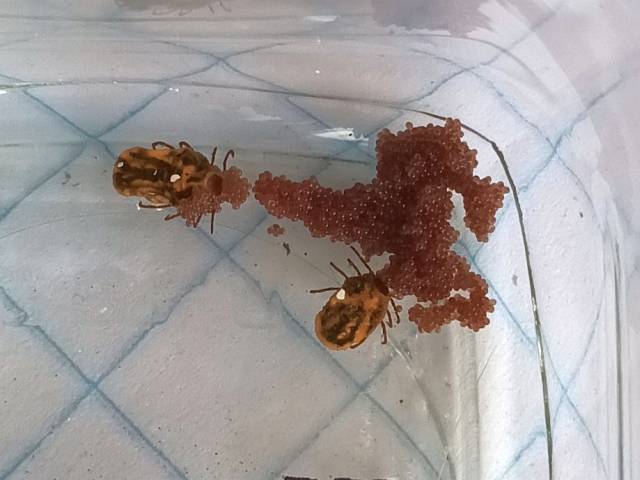
I pulled these two ticks out of a dog and put them in a glass container at once for observation. After a few days, they laid eggs (22 March 2023).
After laying their eggs, they stopped moving and died. Now I’ll wait and see how long it takes for the tick larvae to hatch.
How Long Do Tick Eggs Take To Hatch
How long it takes for the tick larvae to hatch from the eggs depends on the tick species, and the ambient temperature and humidity. If it’s a little warmer they develop a bit faster, at lower temperatures hatching of the tick larvae takes a little longer.
In general, the development of the tick eggs takes between 14 days to about a month until the tick larvae hatch.
So how long did it take for the Tick Larvae to hatch?
I checked the tick eggs every day.
On April 8th the clutch changed and the ticks hatched. It only took a little more than 2 weeks for the ticks to hatch from the eggs. The ticks were locked in a glass jar, the average temperature was 28 degrees C.
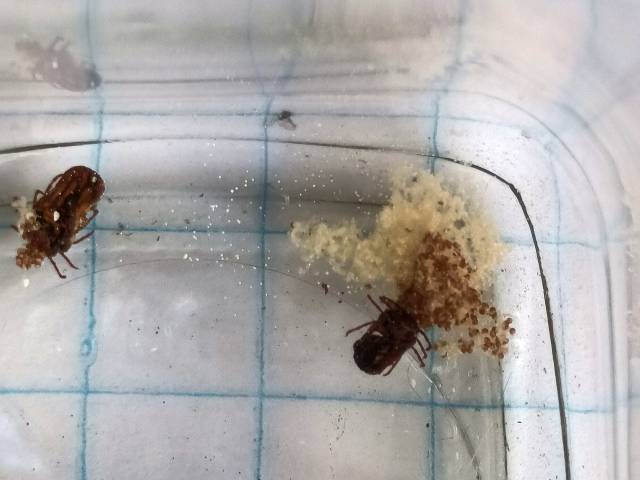
It only took a little more than 2 weeks for the ticks to hatch from the eggs. The ticks were locked in a glass jar, the average temperature was 28 degrees C.
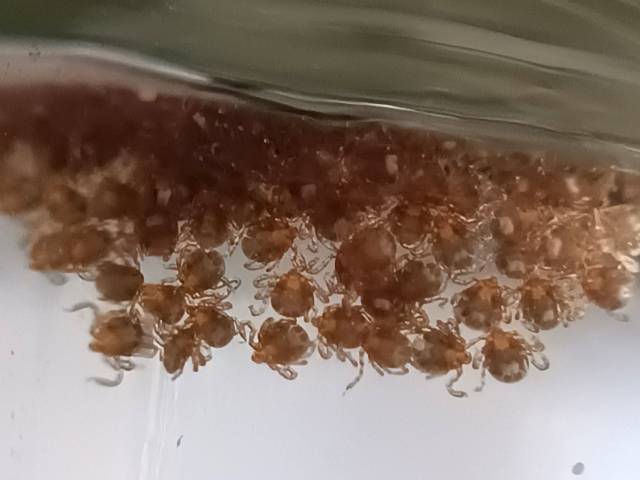
In temperate climate zones such as North America or Europe egg laying often occurs in late summer or autumn. The hatched ticks in these zones then hide on the ground and spend the winter in a dormant state, and then begin their search for a host the following spring.
In tick species found in tropical zones, the larvae begin to crawl around soon after hatching and place themselves on leaves and blades of grass, waiting for a suitable small host animal to come along for a first blood meal.
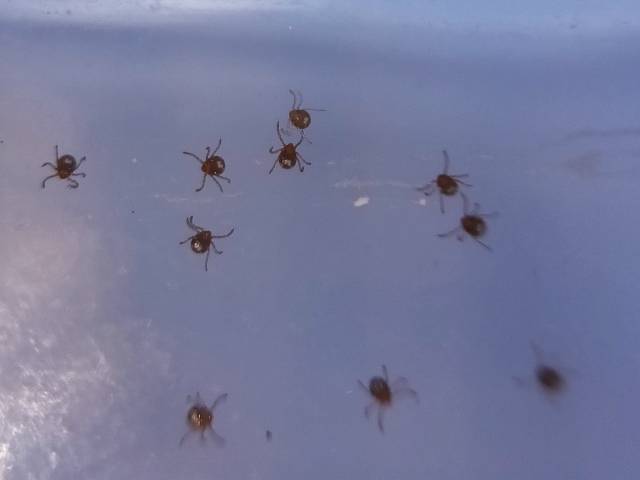
Where do ticks nest?
Tick nests also occur wherever there are suitable host animals for these spider-like parasites. Large, overgrown gardens with plenty of shade and dense vegetation are particularly suitable and liked by ticks.
In such an environment, ticks find a dark, damp place close to the ground, protected from wind and light, where they can lay their eggs undisturbed. So what and where exactly should you look for when looking for a tick nest?
Where to look:
- on moist soils, especially in leaf litter/piles
- near the roots of tall grass, bushes and shrubs
- in densely overgrown flower beds or under flower pots
- check near shady fence posts and walls
- in and under stacked wood
- under rotten tree trunks
- in the compost heap
How to get rid of a tick nest?
Unfortunately, ticks multiply quickly, and everywhere where there weren’t ticks until recently, ticks suddenly appear. Tick-borne diseases are also increasing. So it is obvious that if you find a tick nest in your garden you want to get rid of the tick nest.
- To destroy the tick nest and prevent ticks from hatching from the eggs, it is sufficient to pour boiling water over the eggs.
- Another easy way to get rid of the tick nest is to scoop it up with a small shovel and place the lot on a cardboard box or in a newspaper and burn it.
- You could also sprinkle plain table salt on the tick eggs. This draws the water out of the eggs and destroys them by dehydrating them.
- Or you pick up tick nets with the shovel and put everything in a container with disinfectant or mentholated spirit that will also kill tick eggs.
If you are really 100% sure that it is a tick nest that you have found in your garden, then you might destroy it without hesitation. Although ticks fulfill their purpose in the food chain when you consider how the parasites have spread in recent years, and the increase of tick-transmitted diseases you should prevent them from spreading further.
But avoid using heavy-duty pesticides to destroy tick eggs. In the case of a tick nest, it is not really necessary to apply toxic synthetic insecticides. It can actually be destroyed quite easily with simple mechanical means such as hot water or burning.Is it really a tick nest?Before destroying any weird-looking little bug eggs in the garden, you should be sure what insect they are from and if it really is tick eggs. All too easily, snail eggs or earthworm eggs, or the eggs of beneficial beetles or other predatory insects are mistaken for tick eggs. And if you destroy them, you might destroy a predator bug who likes to eat tick eggs or other unwanted pests from your garden. |
What do tick eggs look like
Here again summarize the most important things you have to look out for to identify a tick nest, where it can be found, and what the tick eggs look like:
- Egg color: orange-red to brownish
- Slightly glossy shine surface (have a protective layer to prevent drying out)
- Egg size: about 0.1 millimeters
- Found in small clutches of thousands of eggs
- Appearance and arrangement similar to snail eggs or worm eggs
- Tick Nest Size: Spread 1 to 2 cm wide depending on the number of eggs
Ticks with eggs
Brown ear tick (Rhipicephalus appendiculatus) with a batch of eggs

Argas sp. Female Argasid tick has laid a batch of eggs

What else can you do against the tick problem
In order to keep the tick populations in your yard and garden low, it helps to maintain a clean and tidy yard. Regularly cut back trees and trim bushes and shrubs. let the sun in. Keep the grass well mowed, and trim heavily overgrown and wildly growing beds.
A particularly important step in preventing tick nests in your yard is to prevent rats, squirrels, and other small rodents from invading your garden. As the ticks themselves cannot move very far, they rely on host animals on which they hitchhike. Place tick tubes in your yard these help to tackle the tick problem right at the root.
If you live in an area where it is difficult to control the little parasites despite all the measures and then you have to spray the yard and garden. There are organic products like neem oil, beneficial nematodes, sprinkling diatomite, planting tick repelling plants, and more. used by rodents with kieselguhr point.
Heavy-duty pesticides should be the means of the last choice and only used if nothing else works. Using pesticides will broadly kill every bug that is crawling in your garden, including many beneficial insects.
Use of personal tick repellents must be considered. Organic products made from herbal resources might be sufficient depending on the scale of the tick problem. If this is not enough, then heavy-duty tick repellents that contain DEET or Picaridin are the best and most reliable protection against the biting parasites.



